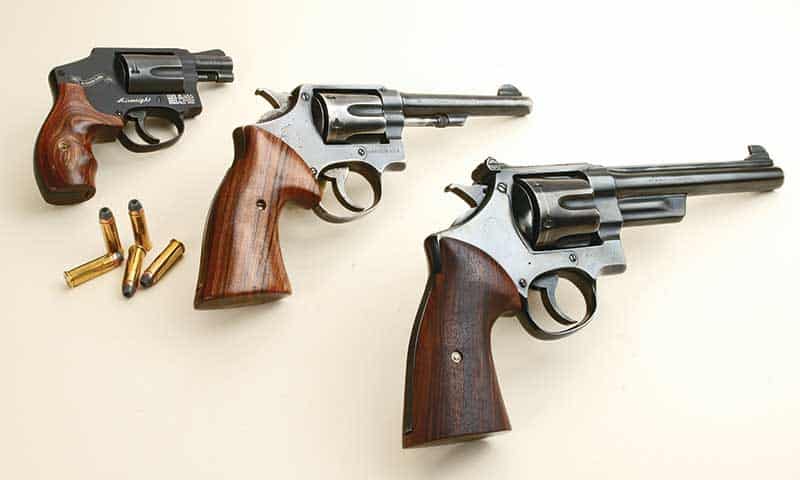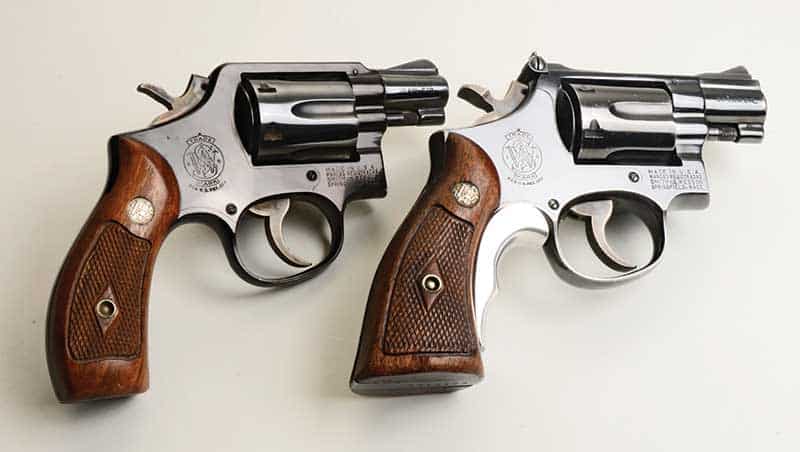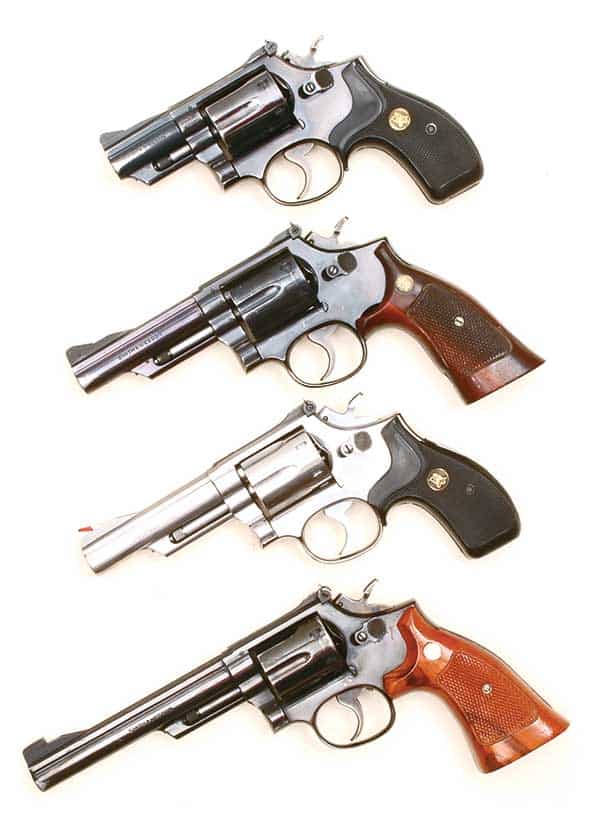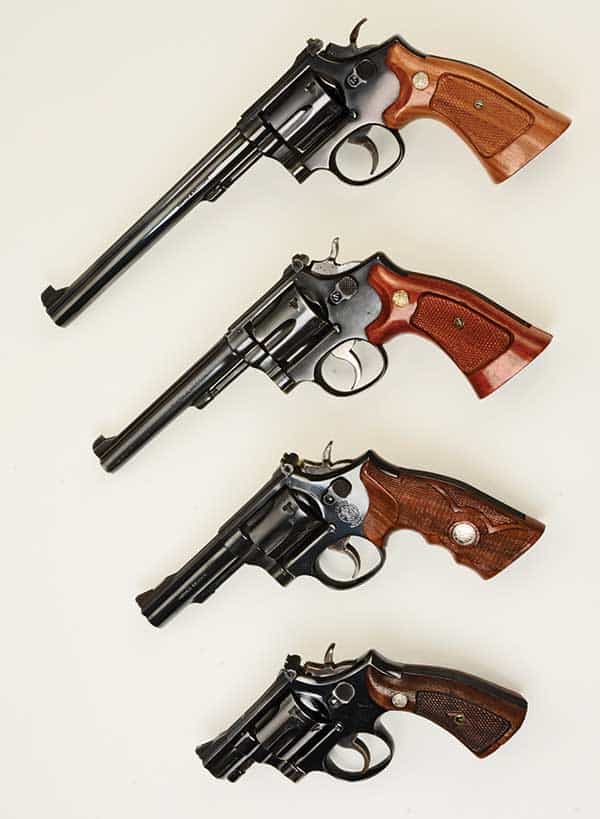The Most "Special" K
Smith & Wesson's Marvelous Middleweight Is The
Undisputed Champ Of DA Revolvers
To me, the greatest single development in double-action revolvers for the 20th century is Smith & Wesson’s introduction of the K-Frame in 1899. Its introductory caliber was .38 Special, although K-Frames have also been chambered for .22 LR, .32 S&W Long, .32-20, .38 S&W and .357 Magnum.
Right now some big bore fanatics are bellering, “Hold up, Duke. The N-Frames are holy. The Smith & Wesson .44 Special is without sin and N-Frame magnums have been movie stars.”
OK. That’s probably true. No movies were ever made about K-Frames I know of. But consider this: Roy Jinks, S&W historian and author of History of Smith & Wesson (13th Printing from 2003), claimed more revolvers built on the K-Frame had been made up to 2003 than all other S&W handguns combined.
S&W used names for their revolvers until 1957. Some K-Frame examples? How about Victory Model, Masterpiece, Combat Masterpiece, Combat Magnum and Military & Police (M&P). After 1957, K-Frames received model numbers such as Model 10 (M&P), Models 14, 16 and 17 (Masterpieces in .38, .32 and .22 sizes respectively) Model 15 Combat Masterpiece and Model 19 Combat Magnum. And there were others.
S&W K-Frames were made in an amazing variety of barrel lengths: 2, 2-1/2, 3, 4, 5, 6, 6-1/2 and 8-3/8 inches. Perhaps I’ve missed one, but most are there. The K-Frame’s intended purposes have been small game hunting (.22), combat (.32, .38 and .357) and bull’s-eye target competition (.22, .32, and .38).
A Frame for Memories
The very first handgun I bought for myself was a K-38 Masterpiece (aka Model 14). I purchased it from a Mr. Robert Hendricks of Red Jacket, W. Va., for the sum of $50. Mr. Hendricks and I later became shooting buddies.
Another shooting buddy at the time was Mike Bucci (nicknamed “Butch”). We were seniors in high school together. His father was chief of police of our small town in the West Virginia coalfields. Mr. Bucci gave his son a K-Frame M&P .38 with a 6-1/2-inch barrel so we didn’t have to share my K-38.
As young fellows more interested in shooting than sitting in classrooms, Butch and I figured out a scam. The easiest class for seniors was journalism. It was the last period of the day and the class’s job was to put out the school newspaper. With neither of us having much interest in writing, Butch was assigned as ad salesman, and I was advertising manager. Butch would tell the teacher, Mrs. Jessie, that he was having trouble selling ads about town and could I help him? (Actually, he’d already filled his quota.) She would give me a pass and Butch and I would hightail it to the gun club 3 miles out of town. We already had our revolvers in the trunks of our cars. Then we’d spend some very pleasant afternoons shooting our K-Frames.
Because we had an “in” with the police department, we’d often pester them to show us what they carried. Almost all were S&W Model 10 M&P .38 Specials, which varied in condition from pristine to rusted shut. One officer had a Model 15 (which we had never seen before). It was—in essence—the same thing as my K-38 except it had a 4-inch barrel. (Later I found out they also made the Model 15 with a 2-inch barrel.)
Another time I was exposed to law enforcement people was in 1974. Then I was working in Yellowstone National Park and was acquainted with a Ranger named Jack Ford. It wasn’t until a passel of Secret Service agents arrived to guard Jack that I realized he was the new President’s son! The agents on this assignment were mostly younger guys, so naturally I engaged them in gun talk. Along with Uzi submachine guns, they had Remington Model 700’s in .308 and some sort of shotgun, I don’t remember. Their handguns were S&W Model 19 .357 Combat Magnums with 2-1/2-inch barrels. One of the agents invited me to come along on their next range day, but the head agent nixed it.
First Picks
Back in West Virginia—being in college and low on funds–Mr. Hendricks made me a deal. He would buy brand-new S&W revolvers, and I could do a set amount of work for them. When I’d worked my way to the purchase prices, I got the guns. They included a 4- and 6-inch Model 19, a 4-inch Model 18 in .22 LR and a Model 12 Airweight .38 Special (a 2-inch snubbie with an aluminum alloy frame.)
By then I was making my summer forays to Montana between college semesters and those K-Frames went with me. My absolute favorite became the 6-inch Model 19. I won a lot of turkeys in cow-pasture competitions with it.
I’ve always been known for having a good memory, but I simply can’t recall where any of those K-Frames went. Regardless, by the late 1970’s, they’d all been sold or traded—even my favorite Model 19. Except for a late 1940’s vintage Military & Police .38 I picked up for $65 in 1978, I was “K-Frameless” for about 25 years.
During that span I was dimly aware Smith & Wesson revolvers were undergoing many changes. There were many types of stainless K-Frames introduced. Then came an L-Frame to fill the gap between the K and N sizes. Also full-length lugs beneath barrels began to appear. This seemed a waste of steel and merely made K-Frames heavier for no reason I could discern.
Then after so many years of non-interest on my part, S&W K-Frames and I were reunited. During the early part of this century, I began building my World War II collection. To add to it, I bought an S&W Victory Model with a 5-inch barrel. It was different from standard M&P .38’s in that it had military Parkerizing and was chambered for .38 S&W (aka .38/200 in British nomenclature). It was one of those Lend-Lease guns sent to Britain during WWII.
America also bought a considerable quantity of Victory Models during the war, but of course chambered for our own .38 Special. Interestingly, most of the wartime K-Frames went to our Navy or Marine Corps aviators and were worn in shoulder holsters. Barrel lengths included 4 and 5 inches. In my cardiac rehab exercise class there is an elderly gent who flew as a rear gunner in a TBF Avenger off the aircraft carrier San Jacinto. He said he carried one of those Smith & Wesson’s until his crew had to ditch in the ocean beside their carrier, and it was lost as he exited the plane. I imagine it joined a passel of other Victory Models at the bottom of the Pacific.
A little known fact is the US Air Force issued K-Frame .38 Combat Masterpieces to guards, MPs and various personnel, and it was mainly at their behest that S&W developed the Airweight versions. In fact, the earliest Air Force K-Frame Airweights also had aluminum cylinders, but this was a failed experiment because they cracked.
Perhaps in an effort to relive my youth, I’ve been buying some K-Frames. However, I’m looking mostly for types I’ve never owned before. In the past few years, I’ve acquired a Model 17-5 .22 LR, a 2-inch Model 15, .38 and a couple of 8-3/8-inch Model 14’s—and even an 8-3/8-inch Model 48 .22 Mag. Some I’ve kept and some I’ve passed on after a bit of shooting. Most recently, I added an M&P 2-inch .38 Special. It’s worn cosmetically but mechanically perfect. Since it was made in the year of my birth, I think it’s a keeper and a good mate to the 5-inch one I bought in 1978.
To close, I will relate one reason I’ve respected K-Frames so much. Once I mounted that 5-inch M&P in my Ransom Rest and from each chamber I fired 10 rounds of Remington 148-grain wadcutters. Then I fired 10 rounds using all six chambers randomly. The average group size of those 70 rounds was a mere 1.1 inches. That wasn’t a fluke. I’ve never had a K-Frame that was a poor shooter.
I guess that’s why I’ve always liked them so much.








